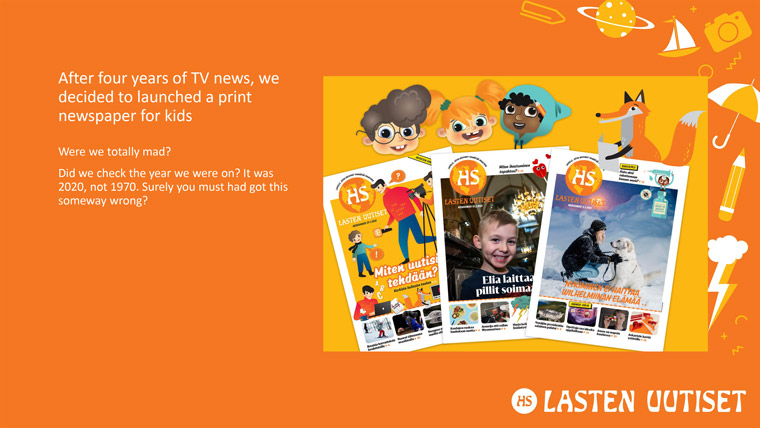Helsingin Sanomat reinvented print media for younger audiences
Conference Blog | 19 January 2022
News media for children can be often overlooked as a product in demand. But Helsingin Sanomat, the largest subscription newspaper in Finland and the Nordic countries, found success creating its own children’s news media — the first time in many years a media company brought news specifically for children to Finland.
Helsingin Sanomat’s youth news concept, Lasten Uutiset (Children’s News), was launched in March 2016 and provides profitable subscription products appealing to young audiences, primarily 8- to 12-year-olds.
“Our goal was to create some kind of goodwill because in other Nordic countries had news for children,” Fanny Fröman, editor-in-chief at Helsingin Sanomat, told INMA members during Webinar on Wednesday. “We realised we have to teach children news literacy because if we don’t, we won’t have any readers in twenty years.”

Lasten Uutiset started with a yearly subscription of a weekly newscast broadcast on television and online.
“Weekly newcast is what we started with and it is now really popular in schools in Finland — almost every primary school in Finland watches this on Fridays,” Fröman said of the newscast’s success.
Social media is also an important part of the Lasten Uutiset strategy, she said: “We use Snapchat and Instagram, that is the way we reach our readers, and our YouTube channel is where we broadcast our newscasts.”
How is Lasten Uutiset operated?
The initiative is the work of a small team, with three journalists and one designer. “Each week we manage to create a 24-page newspaper and one 10-minute newscast,” Fröman said.
And how do they manage to find content for children?
“We try to find topics that actually engage children and show children doing interesting stuff. Or we interview children about something that they know about, or we find a child who can interview an adult,” she said. “We find something to make children a part of it.”
Children also contribute material by giving opinion pieces on books, games, etc. Other content includes collaborations with companies to create learning materials for children.
Fröman brought up some insights on how to give news to children:
“We have to explain it so well that they will understand what is happening, and use easy language so its easy to read, and in some way even tell the bad news in a way that doesn’t make them more afraid. When they get the real information, they become less afraid.
“We try to incorporate the children in what we do so we can show them they have a role in society and that they matter.”
Fröman explained since being apart of Lasten Uutiset, she has realised there is not much difference in what children and adults want to learn in the news:
“Children are interested in all the same stuff adults are. If you ask children what they want to read about, children will want to read all the bad stuff that adults don’t want to tell them, and at the same time the adults themselves want to always read that kind of stuff.”
After doing the livecasts for four years, Lasten Uutiset decided to launch the print newspaper, which thus far has been a success.

The newspaper is colourful and uses graphics, but is not much different than adult newspaper as far as the news content, and it covers all the same topics found in an adult newspaper.
Why launch a childrens newspaper?
People wondered why launch a children’s newspaper when newspapers are rarely read in households anymore. Vesa Lindqvist, strategic partnerships director at Helsingin Sanomat, explained what led the brand to launch a newspaper.
“We were not mad, we did very thorough customer research which indicated a strong demand for print,” Lindqvist stated.
A newspaper company in Norway had great results after launching a children’s print product. “Finnish and Norwegian markets are similar in size and demographics so there was a lot to digest from their experience and gave us the actual understanding that should we do a print product,” Lindqvist said.
Helsingin Sanomat also gathered data from its audience to find out the demand for a childrens print product. “What was surprising for us was there was 23% of the non-subscribers targeted were saying they would be willing to purchase a print product,” he said. “It meant for us there was something unique for us in the market.”

When Lasten Uutiset decided to launch a print product, the responses were overall confusion. Many suggested creating a TikTok channel instead because screens are so appealing to kids in today’s world.
But Lasten Uutiset found there was a demand for a print product and wanted to do something different.
“After validating the demand, we made a plan to presell subs before the launch to get a really good headstart,” Lindqvist explained.
The breakdown
Lasten Uutiset has 216,000 weekly readers ranging in ages from 3 to 16, with the newscast being delivered weekly, primarily on Wednesdays.
Helsingin Sanomat markets Lasten Uutiset to parents and grandparents as an investment in promoting reading for your children and grandchildren. It costs €150 per year.
“Relatively cheap investment in the wellbeing and upbringing of kids, and our subscribers really value the work that we do,” Lindqvist said.
Strategy in launching a niche product in a small market
Helsingin Sanomat has grown to be the biggest subscription newspaper in Finland, mostly from digital subscriptions. To grow Lasten Uutiset, it needed to attract new young subscribers.
“When we look art the needs of our customers, it’s important our customers understand the value of reading and the value of reading news,” Lindqvist said. “It’s important to have a product they can purchase for their kids and lead by example.”
The newspaper was designed to allow children to pick up a news reading habit since watching something on screens is typically how children see online content, he said: “Kids are entitled to read the news and take part in social discussions.”































